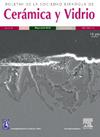微波辅助水热合成纳米氧化钇掺杂氧化锆
IF 2.7
4区 材料科学
Q1 MATERIALS SCIENCE, CERAMICS
Boletin de la Sociedad Espanola de Ceramica y Vidrio
Pub Date : 2025-08-28
DOI:10.1016/j.bsecv.2025.100466
引用次数: 0
摘要
以ZrOCl2·8H2O、YCl3·6H2O和KOH为原料,建立了一种微波辅助水热法制备3和8mol %钇掺杂氧化锆纳米晶(分别命名为Z3Y和Z8Y)的方法。在低温(样品Z3Y为180℃,样品Z8Y为200℃)和短反应时间(30 min)下,通过KOH同时沉淀两种氯化物和氢氧化物脱水进行了合成。采用ICP-OES对整个合成过程中Zr和Y(原液标准化、沉淀度)进行分析控制。两种元素的定量沉淀均大于99.999%。将合成的粉末分别在500℃(试样Z3Y)和800℃(试样Z8Y)下煅烧,并对所得产物进行XRD、FE-SEM、HR-TEM和SAED表征。合成的纳米粒子和煅烧的纳米粒子都是高度结晶的。样品Z3Y的晶相为四方相(单斜相约占20%),样品Z8Y的晶相为纯立方相。未检出其他相的杂质。合成样品Z3Y和Z8Y的平均晶粒尺寸分别为6.2±1.0和3.5±0.7 nm,煅烧样品Z3Y的平均晶粒尺寸分别为8.0±1.2和11.3±1.3 nm。本文章由计算机程序翻译,如有差异,请以英文原文为准。
Microwave-assisted hydrothermal synthesis of nanocrystalline yttria-doped zirconia
An efficient microwave-assisted hydrothermal method was developed for the preparation of nanocrystalline 3 and 8 mol% yttria-doped zirconia (named as Z3Y and Z8Y, respectively) from commercially-available ZrOCl2·8H2O, YCl3·6H2O and KOH. The synthesis was conducted at low temperature (180 °C for sample Z3Y and 200 °C for sample Z8Y) and short reaction time (30 min) by simultaneous precipitation of both chlorides with KOH and dehydration of hydroxides. Analytical control of Zr and Y (standardization of stock solutions, precipitation degree) throughout the entire synthetic process was carried out by ICP-OES. Quantitative precipitation (greater than 99.999%) of both elements was obtained. The as-synthesized powders were calcined at 500 °C (sample Z3Y) and 800 °C (sample Z8Y), and all the resulting products were characterized by XRD, FE-SEM, HR-TEM and SAED. Both the as-synthesized and calcined nanoparticles were highly crystalline. The crystalline phases obtained were tetragonal phase (with a fraction of about 20% monoclinic) for sample Z3Y, and pure cubic phase for sample Z8Y. No impurities from other phases were detected. The average crystallite sizes for the as-synthesized samples Z3Y and Z8Y were 6.2 ± 1.0 and 3.5 ± 0.7 nm, respectively, while for the calcined ones the values were 8.0 ± 1.2 and 11.3 ± 1.3 nm, respectively.
求助全文
通过发布文献求助,成功后即可免费获取论文全文。
去求助
来源期刊

Boletin de la Sociedad Espanola de Ceramica y Vidrio
工程技术-材料科学:硅酸盐
CiteScore
5.50
自引率
2.90%
发文量
72
审稿时长
103 days
期刊介绍:
The Journal of the Spanish Ceramic and Glass Society publishes scientific articles and communications describing original research and reviews relating to ceramic materials and glasses. The main interests are on novel generic science and technology establishing the relationships between synthesis, processing microstructure and properties of materials. Papers may deal with ceramics and glasses included in any of the conventional categories: structural, functional, traditional, composites and cultural heritage. The main objective of the Journal of the Spanish Ceramic and Glass Society is to sustain a high standard research quality by means of appropriate reviewing procedures.
 求助内容:
求助内容: 应助结果提醒方式:
应助结果提醒方式:


